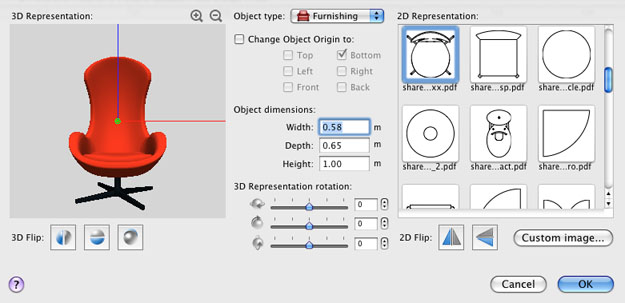
| www.belightsoft.com/liveinterior | Start of Help | Index > Working with Objects |
The Type and Representation dialog lets you change the properties of objects. It opens when you import an object, when you choose the Type and Representation command from the Edit menu, or use the context menu of an object.

The tools in the Type and Representation dialog change only one copy of the object: the one which was selected when you opened the dialog box. Other copies that may be present in your project remain unchanged.
The program uses the same model for all the copies of each object in the project. If you modify one of the copies, the program will have to create one more model specially for the changed object. So, using the Type and Representation dialog you can increase the total number of object models in the project. This may result in a decrease in the program’s performance.
The 3D Representation box displays a preview of the 3D model.
To change the size of the preview picture, click the zoom buttons above the preview.
To rotate the 3D model in the preview, place the mouse pointer above the picture, press the mouse button and drag it to any side. To restore the default
orientation (angle) and magnification of the model in the preview, double-click
on it.
The settings in the preview box do not affect the object, they change the preview picture only.
The Object type is the most important object property. It determines the behavior of the object. You can set it to Furnishing, Window, Door and Stairs. The difference is that windows and doors can be inserted into walls, while furniture cannot. Any object that is not a door or a window, should be specified as Furnishing.
Rotating an object in the Type and Representation dialog means the object will change its default orientation.
Changing the orientation of an imported object is necessary when objects are imported upside-down or when a door or window is inserted across a wall.
To rotate an object, use the Rotate 3D Representation sliders.
It is recommended that you allow the program to update an object's origin after an object is rotated. To do this, select the Change Object Origin to option, keeping its sub-options unchanged.
3D flipping lets you make several objects out of a non-symmetric model.
For example, by applying front-to-back and left-to-right flipping, you can create three new doors from a single door model. This is especially helpful when the door model has a handle on one side but you need a handle on the other side.
To flip an object, click the corresponding 3D Flip button.
The Change Object Origin option allows you to change the origin of an object already added to your project and lets choose an origin for an object are currently importing to your project. Changing the object origin affects the current object’s copy only. Objects in the built-in library never change.
The object origin is a point on the object surface that is used by the program to define the object location in the 2D layout and in the 3D space. By default, the most optimal point on the object is used as the origin.
For instance, the origin is used to rotate an object. When you rotate an object, it rotates around its origin. So, changing the origin may change the object behavior.
The default origin is usually set depending on the object type: for furniture it is the center of the bottom; for wall pictures – center of the back surface; for ceiling lamps – the center of the top.
The default origin is usually set depending on the object type: for furniture this is the center of the bottom; for wall pictures – the center of the back surface; for ceiling lamps – the center of the top.
Object dimensions determine the size of an object. The size can also be modified in the Inspector.
The 2D representation box shows the current object representation for the 2D view.
To choose an image from the library, click on it.
To use a custom image, click the Custom Image button and navigate to the graphic file.
2D flipping mirrors a 2D representation. This is needed for adjusting the orientation of an image for the 2D view to match with the 3D object. For example, after left-to-right flipping of the door, you should flip its image on the floor plan, too.
Note: The 2D and 3D flip operations work independently for better flexibility. Make sure the 2D representation matches the 3D object.